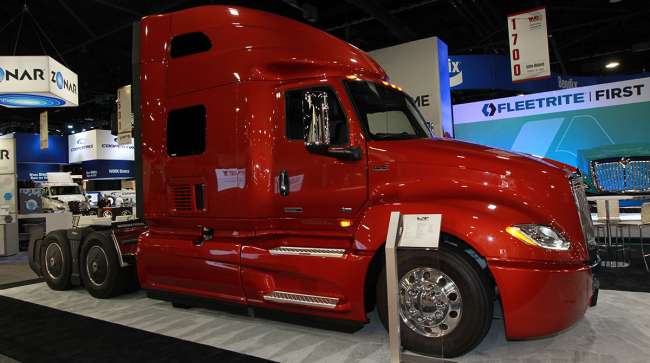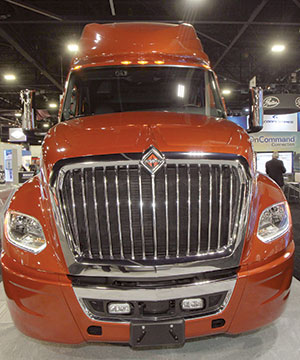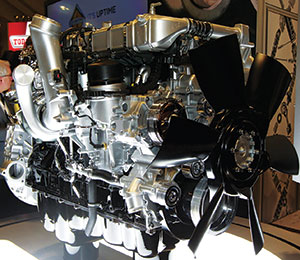Senior Reporter
Navistar’s Net Income, 3Q Revenue Surge on Market Enthusiasm for Trucks, Engines

Navistar International Corp. reported a surge in net income and an 18% increase in revenue for its fiscal year third quarter, citing the market’s enthusiasm for its latest truck and engine products, and expressed confidence that current market conditions would continue into the first half of 2019 — and possibly beyond.
For the period ended July 31, net income was $170 million, or $1.71 per diluted share, compared with $37 million, or 38 cents, a year earlier.
Revenue in the quarter reached $2.6 billion compared with $2.2 billion in the same period one year ago.

Another International 625LT on display in 2018. (John Sommers II for Transport Topics)
“It was a very good, strong quarter, a robust market,” Chairman and CEO Troy Clarke said during a Sept. 6 earnings call. “We are set up for a very strong close to 2018 and a great start to 2019. This is a great time to be in the truck market and it is a great time to be in Navistar.” The company is the parent of International trucks.
In the quarter, the truck segment had a profit of $165 million compared with $7 million for the year-ago period. The improvement was primarily driven by the impact of higher volumes in Navistar’s core markets and lower charges related to legacy engine litigation recorded in the third quarter of 2017, according to the Lisle, Ill.-based company. The segment also benefited from the settlement of a business economic claim.
The division was negatively impacted by industry supplier constraints that resulted in higher company inventory, lower volumes, cost inefficiencies in the assembly process and additional freight costs — issues the company is now working through.
“Parts are now available in sufficient quantities to support production and complete any truck requiring a part,” Clarke said. “Offline inventories have returned to normal and we are working through a delivery backlog of trucks ready to transport to customers and dealers. But the supply chain remains really tight.”
It was a very good, strong quarter, a robust market.
Navistar Chairman and CEO Troy Clarke
He added, “We believe we have a realistic view of supplier capability in our revised guidance.”
Based on stronger industry conditions, the company raised its 2018 full-year guidance: industry retail deliveries of Class 6 through Class 8 trucks and buses in the United States and Canada are forecast to be 390,000 to 410,000 units, with Class 8 retail deliveries of 260,000 to 280,000 units.
The parts segment’s third-quarter net sales hit $605 million, up $19 million compared with the year-ago quarter amid continued double-digit growth of the Fleetrite brand, partially offset by lower Blue Diamond Parts sales.
The parts segment recorded a profit of $144 million, down 8% compared with a year earlier — primarily due to lower proprietary parts sales, higher freight-related expenses and inter-company access fees.
Navistar’s financial services segment saw net revenue increase by $3 million to $65 million year-over-year, primarily due to higher average portfolio balances in the United States and Mexico. But its profit of $23 million was comparable to a year earlier.

Navistar's 13-liter engine, new in 2017. (John Sommers II for Transport Topics)
Navistar said overall third-quarter highlights included 2.7% year-over-year growth in Class 8 heavy-duty retail market share — boosted by strong sales of the International LT Series on-highway truck. There was also growth in the engine division; Navistar’s 12.4-liter A26 engine saw its market share more than double from the year ago quarter. The engine is now also available in International’s severe-service vehicles, the HV Series and HX Series. Additionally, the new MV Series contributed to 66% growth in medium-duty orders.
The company also announced that as of June all of its new on-highway International trucks will be equipped with the company’s proprietary OnCommand Connection telematics, with two free years of service included. The system integrates a cellular-enabled hardware platform with a range of technology solutions, including telematics and the OnCommand Connection remote diagnostics platform.
This is the company’s first telematics product that has additional services that can be purchased or accessed via subscription. In the current pilot stage, fleets have been paying for features such as automated driver inspection, Clarke said.
What he called the “original pod” of OCC customers — using the original free service with a handful of basic services — includes 475,000 trucks that the company is monitoring regularly. About two-thirds of those are not International-branded trucks, and one third are, he said.
Meanwhile, Clarke said the company needed to invest in getting parts to dealers faster, systems support, electric vehicles and brand new diesel powertrains in conjunction with its alliance with Traton Group, formerly known as Volkswagen Truck & Bus, which owns about 17% of Navistar.
“We are going to fund a lot of this through the continuing economies and efficiencies we have been able to generate through investments we have made in [being] a lean enterprise to lower our break-even point,” he said.





